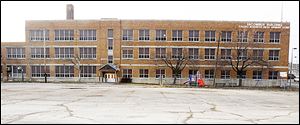
Macomber lives again
2/24/2013
The former Macomber High School could be the new home of Cherry Street Mission Ministries.
Dan Rogers has Toledo’s homeless population covered — literally — with a plan to move Cherry Street Mission Ministries’ operations into the former Macomber High School. The proposal is a victory for the neighborhood around the shuttered vocational school, and for people who have lamented the destruction of too many iconic Toledo buildings.
Maintaining a single location will cut Cherry Street’s overhead costs by 27 percent, Mr. Rogers, the agency’s president and chief executive officer, told The Blade’s editorial board. The Macomber building can accommodate about 30 percent more beds, he says, while making it easier to connect homeless clients with the services they need.
Housing men and women at the same site is a national trend, but women’s safety can be an issue. Mr. Rogers says Macomber is large enough to allow a buffer between men’s and women’s areas, which will be separated by tight security.
Mr. Rogers also has ambitious plans to connect the mission’s homeless shelter with the surrounding community. He wants to renovate Macomber’s 600-seat auditorium and full-sized gymnasium, then open them for public use.
A community center in a homeless shelter will “take time and trust,” Mr. Rogers says. It will require buffer zones between the shelter and other public areas, for the comfort of both clients and other groups. Macomber has plenty of space to handle both.
Creative, adaptive use of existing buildings should be applauded and encouraged. Cherry Street’s purchase of Macomber — pending an engineering report — preserves an artifact of a past era in which the federal government used massive public spending to stimulate local economies across the country.
Macomber High School opened during the final years of the Great Depression. It was built with help from the Public Works Administration, a federal agency created in 1933 under the National Industrial Recovery Act to bolster the economy by funding large-scale public works. Over 10 years, the WPA spent $6 billion on dams, hospitals schools, bridges, and other projects across the United States.
Mr. Rogers says the Macomber building seems to have weathered the ravages of time. In addition to classrooms, science labs, and shop areas that Cherry Street will turn into sleeping areas, offices, and meeting rooms, Macomber has an attractive foyer described by Mr. Rogers as Art Deco. The wooden gymnasium floor, he adds, appears to be in near-perfect condition.
Public officials often argue that at a time of budget austerity, their emphasis must be on paying for essential programs rather than aging brick and mortar. Cherry Street Mission is proving that historic buildings not only can be preserved, but also can enhance an agency’s mission.